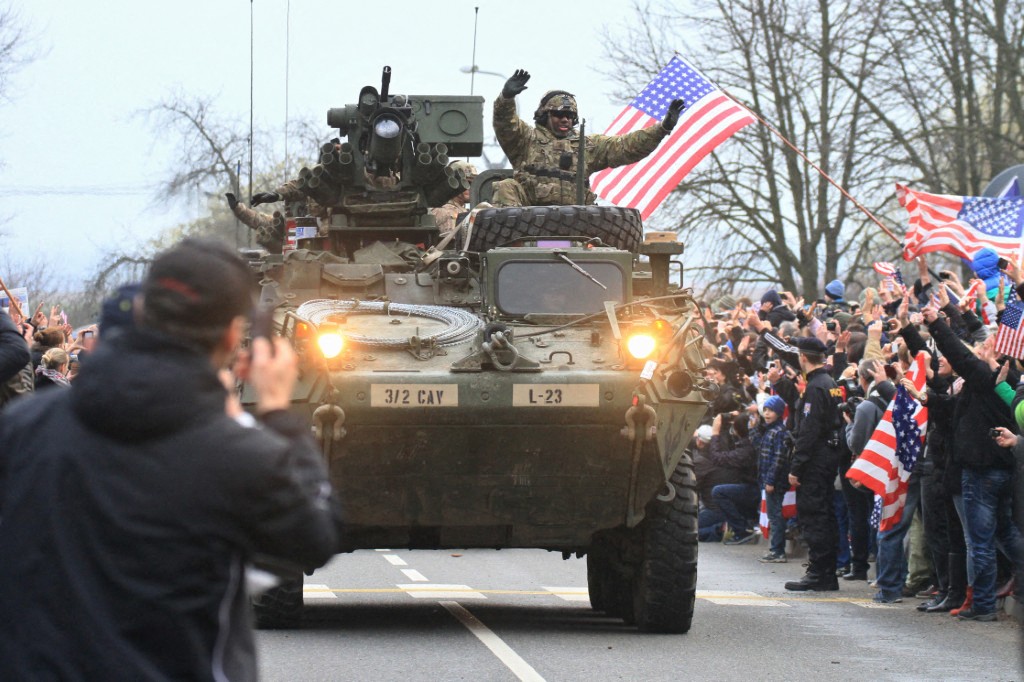Editor’s Note: This is an Opinion Article. The views expressed may not reflect those of the EurAsian Times or the Indian Military.
As US President Donald Trump imposed an additional 25% tariff on Indian goods, raising the total tariffs on Indian products to 50%, among the highest on any country, it is becoming increasingly clear that the issue is not just New Delhi buying Russian oil.
For if that were the case, there are many more deserving candidates for US tariffs. China, for example, has absorbed 48% of Russian oil exports between December 2022 and June 2025, as opposed to India, which has bought 37% of Russian oil exports during the same period.
Similarly, according to data from the Finland-based Centre for Research on Energy and Clean Air (CREA), the EU absorbed 51% of Russia’s LNG exports, followed by China (21%) and Japan (18%).
Since the Russia-Ukraine war began, the EU nations have paid Russia 212 billion Euros (US$247.13 billion) for importing Russian fossil fuels. In comparison, according to CREA data, between February 2022 and March 2025, India bought Russian oil worth US$131.14 billion, even though the Indian population is three times the population of the EU.
Not just the tariffs, the whole tone and tenor of Trump, bordering on open hostility, and disagreements on a range of issues from immigration, H1B visas, US relations with Pakistan, and Washington’s insistence on opening India’s farm and dairy sector (a political no-go for every government), suggest a broader geopolitical realignment.
The US has historically shown itself to be an unreliable security partner; however, Trump’s weekly U-turns have done long-term reputational damage to Washington.
Meanwhile, amid Trump’s daily threats to New Delhi, Pakistan’s Army Chief Gen Asim Munir will visit the US again, for the second time in as many months.
In this changed geopolitical environment, India will be foolish not to read the signs and still count Washington as a reliable security partner.
Speaking on the issue, Col Harendra Singh (retd), Kumaon Regiment, told EurAsian Times, “America is an absolutely unreliable ally; they will ditch you when you need arms and equipment against Pakistan. The Russia-India-China (RIC) axis must open up; it will have peace and tranquility at LAC and teach a lesson to America.”
Consequently, there is an urgent need to review all outstanding defense pacts with the US, and perhaps, none is more worthy of immediate suspension than the ill-planned, unjustified, and illogical Stryker deal.
For unlike the GE-supplied F404 and F414 jet engine deals, for which India has no alternatives, New Delhi has indigenous alternatives available to Stryker Infantry Combat Vehicles (ICVs), which will not only support India’s self-reliance goals in the defense field, but the domestically-produced variants are also more capable, more suited to Indian conditions, and cost-competitive.
The Stryker Deal
India and the US are in the final stages of finalizing the Stryker deal.
The Indian Defense Ministry has proposed a three-phase plan for the project. Valued at approximately US$1.5 billion for 530 units, it seeks to phase out India’s outdated Russian BMP-IIs. The plan unfolds in three stages: initial procurement through US Foreign Military Sales, joint production in India, and co-development of tailored variants.
Produced in India, the armored vehicles are also expected to be exported to third countries.
The Strykers could be deployed in high-altitude areas along the border with China in regions like Eastern Ladakh and Sikkim.
The Strykers: The Ghost Soldiers Of The Iraq War
The Stryker is an 8-wheel-drive combat vehicle developed by General Dynamics Land Systems-Canada for the US.
The US has been aggressively advocating for India to purchase the armored vehicle, which is powered by a Caterpillar C7 engine with 350 horsepower, has a range of 483 kilometers, and can run at a maximum speed of 100 km/h.
It has bolt-on ceramic armor for enhanced protection and can withstand improvised explosive devices.

The Stryker variants include Infantry Carrier Vehicles, Mobile Gun Systems, medical evacuation vehicles, fire support vehicles (ICV), anti-tank guided missile carriers, and reconnaissance vehicles.
It has been 20 years since the Stryker made its debut during Operation Iraqi Freedom II. During this operation, the 3rd Brigade, 2nd Infantry Division (now 1-2 Stryker Brigade Combat Team) earned its nickname ‘Ghost Soldiers.’
The Ghost Brigade was the first to operate the vehicle. The occupants of the armored vehicle were kept safe from conventional weapons like rocket-propelled grenades. However, the defeat of Saddam Hussein’s Army led to the rise of the use of Improvised Explosive Devices (IEDs). During one such large IED attack in Iraq, the Stryker sustained extensive damage, but the crew came out unscathed.
It earned the reputation amongst the US Armed Forces that “not only could these trucks bring you to the fight, but they could bring you home.”
Since its introduction in 2002, more than 4,900 Strykers have entered active service, most of them going to the US Army.
India’s Indigenous Strykers: Tata-Manufactured WhAP
The WhAP (Wheeled Armoured Platform) was initially developed as the TATA Kestrel, which was classified as an IPMV (Infantry Protected Mobility Vehicle).
Tata Motors developed the Kestrel in response to a request for information (RFI) for the supply of chassis, propulsion unit, and weapon system for a wheeled armored amphibious platform under the Indian Army’s Future Infantry Combat Vehicle (FICV) program.
The Kestrel was conceptualized to replace the older Soviet-era BMP-1 and BMP-2 armored personnel carriers used by the Indian Army.
The Kestrel was developed in close collaboration with the DRDO and the Indian Army. Tata Motors first showcased it at the Defexpo 2014, featuring the Kongsberg PROTECTOR MCT-30R turret.
The platform underwent extensive trials in various terrains, including deserts, high altitudes, and plains, to ensure that it met the Indian Army’s stringent requirements.
During these trials, the vehicle’s mobility, durability, and protective features were thoroughly tested. The vehicle’s ability to withstand blasts and firepower was also a major focus.
Tata Motors unveiled a new variant of the Kestrel, WhAP, at the 2017 Aero India defense exhibition.

After the trials were completed, Tata Motors announced that the WhAP was ready for mass production. This vehicle was India’s first indigenously developed 8×8 wheeled armored vehicle, and it represented a major step forward in the country’s defense manufacturing capabilities.
Dr. S. Guruprasad, former director of Research and Development Establishment (Engineers), a DRDO laboratory, at Dighi, told the EurAsian Times: “WhAP is an excellent, proven technology. It has been tested at high altitudes. The Army was impressed by its performance.”
Should India Axe Stryker Deal?
Firstly, and this point can not be stressed enough, Tata-manufactured WhAP is a wholly indigenous product.
If India picks WhAP over Stryker, it will be a big boost to India’s goal of self-reliance in the defense field.
As India has learned over the years, often at tremendous costs, that the US is an unreliable partner, New Delhi must prioritize an indigenous platform over a US-made defense platform.
India’s reliance on the US for critical defense platforms is a strategic weakness that Washington can exploit at any time.
India learned this recently due to its reliance on the US for the supply of critical jet engines. The delay by General Electric (GE) in supplying the F-404 jet engines has delayed India’s indigenous LCA Tejas program by at least two years. Not just that, realising India’s strategic weakness, GE is also trying to extract more money from India for these jet engines.
Secondly, WhAPs are priced around 3 to 4 million USD, about 30 to 50% cheaper than their Western competitors.
But most importantly, WhAPs are more suited to the Indian Army’s requirements.
The Tata WhAP and the Stryker are both 8×8 ICVs with a top speed of around 100 kph and a range of nearly 500 km.
The WhAP is highly modular. It can be configured as an amphibious fighting vehicle capable of crossing rivers and lakes or operating in coastal areas. The capability is important, considering India’s geographical diversity.
WhAP modularity additionally facilitates upgrades to higher levels of protection based on mission needs. It offers protection against small arms fire and mine resistance, potentially up to STANAG Level 3 or higher.
The WhAP can be fitted with a 30mm automatic cannon, anti-tank guided missiles (ATGMs), and machine guns (7.62mm or 12.7mm), making it versatile in terms of firepower.
The Stryker platform is less modular. The basic platform is typically armed with a 12.7mm M2 Browning heavy machine gun or a 40mm automatic grenade launcher in a Remote Weapon Station (RWS).
The Stryker takes a non-modular approach to enhanced firepower. The Stryker arguably features better default protection. It comes with steel armor that provides protection against 14.5mm armor-piercing rounds, and it can be equipped with slat armor or composite armor for increased survivability, particularly against RPGs and IEDs.
In terms of power, the WhAP has a 600-hp (Cummins ISXe 600) power pack, while the Stryker has a 350-hp (Caterpillar C7).
The Tata WhAP is designed for versatility across diverse terrains, with features like amphibious capability, a powerful engine, and an adjustable suspension system.
The Stryker, on the other hand, is optimized for urban combat and lacks the WhAP’s amphibious and extreme off-road capabilities.
Furthermore, Stryker has been found wanting in its Indian trials.
Last month, India’s defense secretary Rajesh Kumar Singh disclosed that Stryker failed to meet the operational requirements of the Indian Army during field trials. Singh underlined that Stryker lacked amphibious capabilities, a critical requirement for the Indian Army, given India’s diverse and challenging terrain.
Singh added that the US has committed to showcasing an amphibious variant of the Stryker in the future. However, India already has this capability in the TATA-manufactured WhAPs.
Speaking to EurAsian Times, Indian Army veteran Lt Col JS Sodhi said that India should turn the Trump tariffs into an opportunity to strengthen India’s domestic arms industry and to prepare for a two-front war situation, which is a reality.
“The Trump tariffs provide India a golden opportunity to further India’s ‘Make in India’ initiative. We have a five-year window to prepare for a two-front war situation. During a war, it is always better to have a robust domestic arms industry, as other countries could impose sanctions and arms embargoes.”
“Since TATAs are already manufacturing an Infantry Combat Vehicle, India should definitely explore the domestic alternative. Though the final decision rests with the Army Headquarters, which will decide extensive field trials, we should make a conscious effort to develop our own weapon systems, even if they are found lacking on certain parameters.”
“Two-front war is no longer a possibility, but a reality,” as Indian Army Chief General Upendra Dwivedi highlighted earlier this year.
“Given the current geopolitical realignments, no one can guarantee which country will support you during a war situation. Hence, the need to develop indigenous weapon systems as far as possible.”
In light of Trump’s open hostility, New Delhi could review many defense deals. India could begin by suspending talks on the Stryker deal just on its merits, which would also send a signal to Washington that India could also hit back to protect its national interests and sovereignty.
- Sumit Ahlawat has over a decade of experience in news media. He has worked with Press Trust of India, Times Now, Zee News, Economic Times, and Microsoft News. He holds a Master’s Degree in International Media and Modern History from the University of Sheffield, UK.
- VIEWS PERSONAL OF THE AUTHOR.
- He can be reached at ahlawat.sumit85 (at) gmail.com



